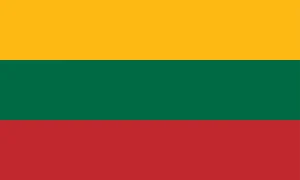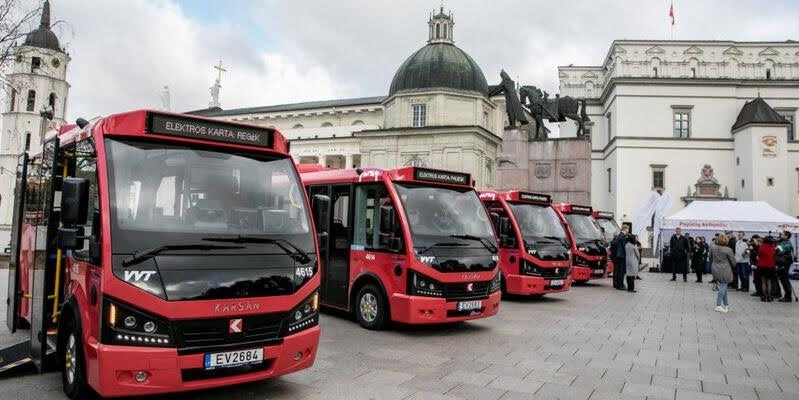Lithuania faces a challenge in its journey towards decarbonising the public transport sector, particularly in terms of adopting zero-emission buses.
The country currently has a fleet of more than 8,107 vehicles (classes M2 and M3), of which around one third is public transport.
What is at stake? The goal is to transform the sector so that, by 2026, 100% of the vehicles procured through public tenders are powered by alternative fuels, with at least half of them being completely CO2-free.
This is confirmed by the Ministry of Transport and Communications to Mobility Portal Europe.
Around 11.7% of all buses are already running on sustainable energy sources.
“In projects funded by the European Union and national resources between 2014-2020, a total of 189 public buses units were acquired, including 51 electric buses,” the Ministry points out.
However, the new requirements present a challenge, prompting the agency to devise a strategy.
Current measures include financial incentives for acquiring electric and hydrogen-powered vehicles.
The aim is to encourage the purchase of at least 500 more clean public transport vehicles by 2029.
The focus is on promoting the use of environmentally friendly urban and suburban public transport vehicles, along with the necessary charging or refuelling infrastructure.
How will this be accomplished?
According to the Ministry, subsidies are being encouraged to stimulate not only the purchase or production of fossil-fuel buses in the M2 and M3 classes, but also their conversion from polluting to electric models.
This will enable the public transport sector to advance more swiftly towards energy transition without relying solely on the purchase of new vehicles.
These are practical measures to accelerate emission reductions, taking into account the needs of the market itself.
Investments of 2.04 million euros are planned to promote the conversion/upgrading of polluting vehicles (M2 and M3) to zero-emission vehicles alone.
In addition, the development of charging and refuelling infrastructure, separately and exclusively for public transport, is a cornerstone of the Lithuanian Roadmap.
By 2026, at least four hydrogen stations are planned to be established, a figure set to double to ten, comprising both public and private stations, by 2030.
This rollout is part of a broader initiative that also includes the construction of 300 “refuelling” points for heavy electric vehicles, including intercity buses.
The measures of the incentive scheme are not only targeted at public transport.
Since 2023, Lithuania has launched a support scheme for the purchase of freight EVs, offering subsidies ranging from 12,000 euros for M2 buses to 60,000 euros for M3 buses.
The aim of this programme is to accelerate the incorporation of EVs in heavy transport, which, to date, registered only around eight eTrucks across the Baltic region.
Although the financial support programme for electric lorry purchases has not yet been released, sources have informed Mobility Portal Europe that between 10 million and 13 million euros will be allocated in upcoming calls.
This initiative will provide an expected incentive of 50,000 euros per vehicle.
And that’s not all.
As part of its sustainable urban mobility plans, the Ministry of Transport and Communications also launched a series of programmes that fund improvements in public transport.

Development of the Sustainable Urban Mobility Plans (SUMPs)
“Eligible applicants for SUMPs include municipalities with more than 25,000 residents and cities with resort status,” the Ministry elaborated.
These initiatives encompass the adaptation of streets and transport infrastructure to facilitate the efficient use of electric buses.
Additionally, they include the creation of intelligent transport systems to enhance coordination between public and private transport.
These measures are designed not only to improve the sustainability of transport but also to improve accessibility for all citizens, including those with special needs.
Another crucial activity is the adaptation of streets and other urban infrastructure to the requirements of public transport.
A key aspect is the introduction and development of interoperability systems between public and private transport, alongside the integration of bicycle infrastructure and systems.
“The implementation of all SUMPs is estimated to require 2.2 billion euros, part of which is expected to be financed from EU structural funds between 2021 and 2027”, they state.
What obstacles is Lithuania facing in this process?
The main challenges for the renewal and attractiveness of public transport, according to the Ministry, is not the lack of funds to transform the fleet to alternative fuels.
Actually, plenty of funds have already been ensured.
Rather, the main challenge is to change the population’s attitude towards public transport and its’ attractiveness.
Step by step, Lithuania is moving towards making it possible to travel quickly, comfortable and conveniently.
By 2029, all public road transport must use alternative fuels.
The aim is to increase the use of public road transport in the country by at least 20% by 2030 (from 12% in 2017 to 18%).








